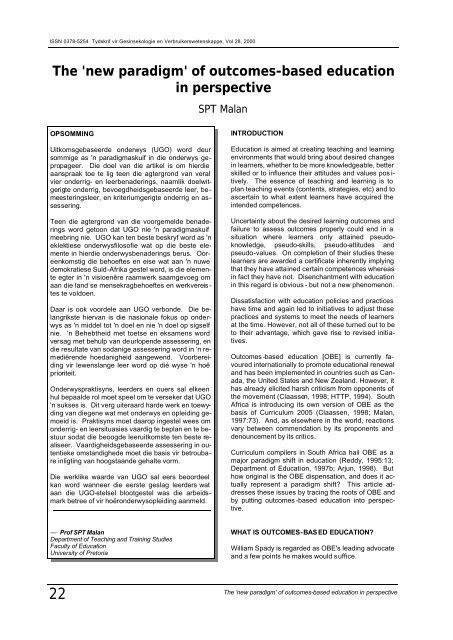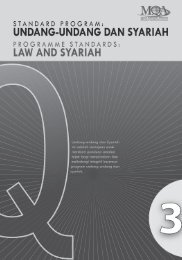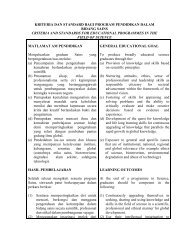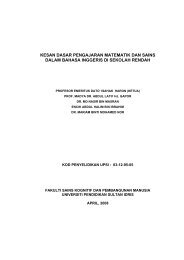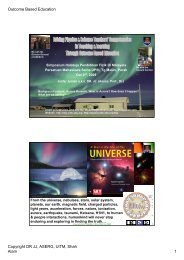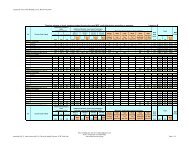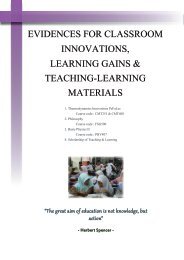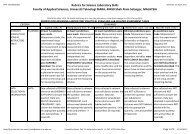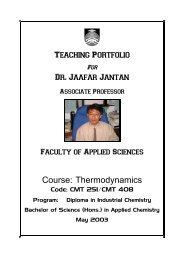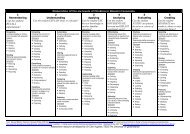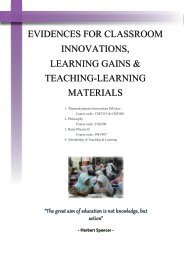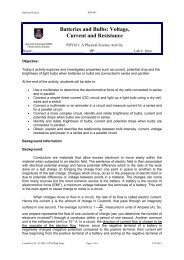The 'new paradigm' of outcomes-based education in perspective
The 'new paradigm' of outcomes-based education in perspective
The 'new paradigm' of outcomes-based education in perspective
You also want an ePaper? Increase the reach of your titles
YUMPU automatically turns print PDFs into web optimized ePapers that Google loves.
ISSN 0378-5254 Tydskrif vir Ges<strong>in</strong>sekologie en Verbruikerswetenskappe, Vol 28, 2000<br />
<strong>The</strong> <strong>'new</strong> <strong>paradigm'</strong> <strong>of</strong> <strong>outcomes</strong>-<strong>based</strong> <strong>education</strong><br />
<strong>in</strong> <strong>perspective</strong><br />
SPT Malan<br />
OPSOMMING<br />
Uitkomsgebaseerde onderwys (UGO) word deur<br />
sommige as 'n paradigmaskuif <strong>in</strong> die onderwys gepropageer.<br />
Die doel van die artikel is om hierdie<br />
aanspraak toe te lig teen die agtergrond van veral<br />
vier onderrig- en leerbenader<strong>in</strong>gs, naamlik doelwitgerigte<br />
onderrig, bevoegdheidsgebaseerde leer, bemeester<strong>in</strong>gsleer,<br />
en kriteriumgerigte onderrig en assesser<strong>in</strong>g.<br />
Teen die agtergrond van die voorgemelde benader<strong>in</strong>gs<br />
word getoon dat UGO nie 'n paradigmaskuif<br />
meebr<strong>in</strong>g nie. UGO kan ten beste beskryf word as 'n<br />
eklektiese onderwysfilos<strong>of</strong>ie wat op die beste elemente<br />
<strong>in</strong> hierdie onderwysbenader<strong>in</strong>gs berus. Ooreenkomstig<br />
die behoeftes en eise wat aan 'n nuwe<br />
demokratiese Suid-Afrika gestel word, is die elemente<br />
egter <strong>in</strong> 'n visioenêre raamwerk saamgevoeg om<br />
aan die land se mensekragbehoeftes en werkvereis -<br />
tes te voldoen.<br />
Daar is ook voordele aan UGO verbonde. Die belangrikste<br />
hiervan is die nasionale fokus op onderwys<br />
as 'n middel tot 'n doel en nie 'n doel op sigself<br />
nie. ‘n Behebtheid met toetse en eksamens word<br />
versag met behulp van deurlopende assesser<strong>in</strong>g, en<br />
die resultate van sodanige assesser<strong>in</strong>g word <strong>in</strong> ‘n remediërende<br />
hoedanigheid aangewend. Voorbereid<strong>in</strong>g<br />
vir lewenslange leer word op dié wyse 'n hoë<br />
prioriteit.<br />
Onderwyspraktisyns, leerders en ouers sal elkeen<br />
hul bepaalde rol moet speel om te verseker dat UGO<br />
'n sukses is. Dit verg uiteraard harde werk en toewyd<strong>in</strong>g<br />
van diegene wat met onderwys en opleid<strong>in</strong>g gemoeid<br />
is. Praktisyns moet daarop <strong>in</strong>gestel wees om<br />
onderrig- en leersituasies vaardig te beplan en te bestuur<br />
sodat die beoogde leeruitkomste ten beste realiseer.<br />
Vaardigheidsgebaseerde assesser<strong>in</strong>g <strong>in</strong> outentieke<br />
omstandighede moet die basis vir betroubare<br />
<strong>in</strong>ligt<strong>in</strong>g van hoogstaande gehalte vorm.<br />
Die werklike waarde van UGO sal eers beoordeel<br />
kan word wanneer die eerste geslag leerders wat<br />
aan die UGO-stelsel blootgestel was die arbeidsmark<br />
betree <strong>of</strong> vir hoëronderwysopleid<strong>in</strong>g aanmeld.<br />
INTRODUCTION<br />
Education is aimed at creat<strong>in</strong>g teach<strong>in</strong>g and learn<strong>in</strong>g<br />
environments that would br<strong>in</strong>g about desired changes<br />
<strong>in</strong> learners, whether to be more knowledgeable, better<br />
skilled or to <strong>in</strong>fluence their attitudes and values pos i-<br />
tively. <strong>The</strong> essence <strong>of</strong> teach<strong>in</strong>g and learn<strong>in</strong>g is to<br />
plan teach<strong>in</strong>g events (contents, strategies, etc) and to<br />
ascerta<strong>in</strong> to what extent learners have acquired the<br />
<strong>in</strong>tended competences.<br />
Uncerta<strong>in</strong>ty about the desired learn<strong>in</strong>g <strong>outcomes</strong> and<br />
failure to assess <strong>outcomes</strong> properly could end <strong>in</strong> a<br />
situation where learners only atta<strong>in</strong>ed pseudoknowledge,<br />
pseudo-skills, pseudo-attitudes and<br />
pseudo-values. On completion <strong>of</strong> their studies these<br />
learners are awarded a certificate <strong>in</strong>herently imply<strong>in</strong>g<br />
that they have atta<strong>in</strong>ed certa<strong>in</strong> competences whereas<br />
<strong>in</strong> fact they have not. Disenchantment with <strong>education</strong><br />
<strong>in</strong> this regard is obvious - but not a new phenomenon.<br />
Dissatisfaction with <strong>education</strong> policies and practices<br />
have time and aga<strong>in</strong> led to <strong>in</strong>itiatives to adjust these<br />
practices and systems to meet the needs <strong>of</strong> learners<br />
at the time. However, not all <strong>of</strong> these turned out to be<br />
to their advantage, which gave rise to revised <strong>in</strong>itiatives.<br />
Outcomes -<strong>based</strong> <strong>education</strong> [OBE] is currently favoured<br />
<strong>in</strong>ternationally to promote <strong>education</strong>al renewal<br />
and has been implemented <strong>in</strong> countries such as Canada,<br />
the United States and New Zealand. However, it<br />
has already elicited harsh criticism from opponents <strong>of</strong><br />
the movement (Claassen, 1998; HTTP, 1994). South<br />
Africa is <strong>in</strong>troduc<strong>in</strong>g its own version <strong>of</strong> OBE as the<br />
basis <strong>of</strong> Curriculum 2005 (Claassen, 1998; Malan,<br />
1997:73). And, as elsewhere <strong>in</strong> the world, reactions<br />
vary between commendation by its proponents and<br />
denouncement by its critics.<br />
Curriculum compilers <strong>in</strong> South Africa hail OBE as a<br />
major paradigm shift <strong>in</strong> <strong>education</strong> (Reddy, 1995:13;<br />
Department <strong>of</strong> Education, 1997b; Arjun, 1998). But<br />
how orig<strong>in</strong>al is the OBE dispensation, and does it actually<br />
represent a paradigm shift This article addresses<br />
these issues by trac<strong>in</strong>g the roots <strong>of</strong> OBE and<br />
by putt<strong>in</strong>g <strong>outcomes</strong> -<strong>based</strong> <strong>education</strong> <strong>in</strong>to <strong>perspective</strong>.<br />
— Pr<strong>of</strong> SPT Malan<br />
Department <strong>of</strong> Teach<strong>in</strong>g and Tra<strong>in</strong><strong>in</strong>g Studies<br />
Faculty <strong>of</strong> Education<br />
University <strong>of</strong> Pretoria<br />
WHAT IS OUTCOMES-BAS ED EDUCATION<br />
William Spady is regarded as OBE's lead<strong>in</strong>g advocate<br />
and a few po<strong>in</strong>ts he makes would suffice.<br />
22<br />
<strong>The</strong> <strong>'new</strong> <strong>paradigm'</strong> <strong>of</strong> <strong>outcomes</strong>-<strong>based</strong> <strong>education</strong> <strong>in</strong> <strong>perspective</strong>
ISSN 0378-5254 Journal <strong>of</strong> Family Ecology and Consumer Sciences, Vol 28, 2000<br />
Spady (1994:1) def<strong>in</strong>es OBE as a … comprehensive<br />
approach to organiz<strong>in</strong>g and operat<strong>in</strong>g an <strong>education</strong><br />
system that is focused on and def<strong>in</strong>ed by the successful<br />
demonstrations <strong>of</strong> learn<strong>in</strong>g sought from each student.<br />
Outcomes are … clear learn<strong>in</strong>g results that we<br />
want students to demonstrate at the end <strong>of</strong> significant<br />
learn<strong>in</strong>g experiences … and … are actions and performances<br />
that embody and reflect learner competence<br />
<strong>in</strong> us<strong>in</strong>g content, <strong>in</strong>formation, ideas, and tools<br />
successfully (Spady, 1994:2). Regard<strong>in</strong>g the OBE<br />
paradigm, Spady (1994:8) states: … WHAT and<br />
WHETHER students learn successfully is more important<br />
than WHEN and HOW they learn someth<strong>in</strong>g.<br />
Ten key components underlie what is termed the <strong>outcomes</strong><br />
-<strong>based</strong> <strong>in</strong>formation age paradigm (Spady,<br />
1994:36-40). At issue here is whether it is <strong>in</strong> fact a<br />
new <strong>education</strong> paradigm.<br />
THE ROOTS OF OBE<br />
Spady (1994:4) concedes that the world is filled with<br />
examples <strong>of</strong> <strong>outcomes</strong> -<strong>based</strong> models, and even that<br />
<strong>outcomes</strong> -<strong>based</strong> systems go back at least 500 years<br />
to the craft guilds <strong>of</strong> the Middle Ages. <strong>The</strong> concept <strong>of</strong><br />
<strong>outcomes</strong> -<strong>based</strong> models and systems is therefore not<br />
new.<br />
Analysis <strong>of</strong> <strong>education</strong>al reform movements <strong>in</strong> the past<br />
reveals prom<strong>in</strong>ent features <strong>of</strong> OBE embedded <strong>in</strong> the<br />
<strong>education</strong>al approaches described below.<br />
<strong>The</strong> <strong>education</strong>al objectives movement<br />
Incongruity between what is be<strong>in</strong>g taught and what is<br />
be<strong>in</strong>g learned led to the sett<strong>in</strong>g <strong>of</strong> objectives for teachers<br />
and learners. McAvoy (1985:28) traced the documented<br />
use <strong>of</strong> objectives <strong>in</strong> <strong>education</strong> back as far as<br />
1860 when Spencer <strong>in</strong> Brita<strong>in</strong> formulated objectives<br />
accord<strong>in</strong>g to a classification <strong>of</strong> human activities. In<br />
1924 Herbart <strong>in</strong> Germany stressed the importance <strong>of</strong><br />
lesson plann<strong>in</strong>g and stat<strong>in</strong>g objectives to guide teach<strong>in</strong>g<br />
activities. In 1949 Tyler gave further impetus to<br />
the objectives-oriented movement by stress<strong>in</strong>g the<br />
importance <strong>of</strong> objectives <strong>in</strong> curriculum design and<br />
teach<strong>in</strong>g practices. He listed four questions as the<br />
basis for his means -end or product-oriented rationale<br />
for curriculum design (Tyler, <strong>in</strong> Arjun, 1998:24):<br />
♦ What <strong>education</strong>al objectives should the school aim<br />
to achieve<br />
♦ How does one select learn<strong>in</strong>g experiences that<br />
are likely to be useful <strong>in</strong> atta<strong>in</strong><strong>in</strong>g these objectives<br />
♦ How should learn<strong>in</strong>g experiences be organised for<br />
effective <strong>in</strong>struction<br />
♦ How would the effectiveness <strong>of</strong> learn<strong>in</strong>g experiences<br />
be evaluated<br />
<strong>The</strong> <strong>'new</strong> <strong>paradigm'</strong> <strong>of</strong> <strong>outcomes</strong>-<strong>based</strong> <strong>education</strong> <strong>in</strong> <strong>perspective</strong><br />
Tyler's rationale has been used extensively by curriculum<br />
practitioners and formed the basis <strong>of</strong><br />
Wheeler's well-known model <strong>of</strong> curriculum design<br />
which served as the ma<strong>in</strong> curriculum design model for<br />
several decades (Arjun, 1998:24). <strong>The</strong> basic OBE philosophy<br />
for curriculum design is firmly rooted <strong>in</strong> both<br />
Tyler's and Wheeler’s models.<br />
Dur<strong>in</strong>g the fifties the work <strong>of</strong> Bloom (1956) and his coworkers<br />
on develop<strong>in</strong>g taxonomies for <strong>education</strong>al<br />
objectives became important. <strong>The</strong>se benchmarks<br />
were used <strong>in</strong> the formulation <strong>of</strong> objectives and the development<br />
<strong>of</strong> criteria to establish whether learners<br />
have actually atta<strong>in</strong>ed acceptable standards compared<br />
to the desired learn<strong>in</strong>g <strong>outcomes</strong>. Bloom's<br />
(1956) work, particularly <strong>in</strong> the cognitive doma<strong>in</strong>, rema<strong>in</strong>s<br />
<strong>in</strong>valuable for OBE assessment.<br />
After Bloom came Mager whose work was first published<br />
<strong>in</strong> 1962. It … captured the imag<strong>in</strong>ation <strong>of</strong> many<br />
teachers and helped spark <strong>of</strong>f a wave <strong>of</strong> enthusiasm<br />
(and controversy) over objectives (McAvoy, 1985:29).<br />
Guidel<strong>in</strong>es (HTTP, 1999) on how to write learn<strong>in</strong>g <strong>outcomes</strong><br />
<strong>in</strong> OBE closely resemble Mager's (1984:23-<br />
104) guidel<strong>in</strong>es <strong>in</strong> terms <strong>of</strong> expected performance, the<br />
conditions under which it is atta<strong>in</strong>ed, and the standards<br />
for assess<strong>in</strong>g quality.<br />
<strong>The</strong> competency-<strong>based</strong> movement<br />
Competency-<strong>based</strong> <strong>education</strong> was <strong>in</strong>troduced <strong>in</strong><br />
America towards the end <strong>of</strong> the 1960s <strong>in</strong> reaction to<br />
concerns that students are not taught the skills they<br />
require <strong>in</strong> life after school. <strong>The</strong> same concern has<br />
been expressed about <strong>education</strong> <strong>in</strong> South Africa.<br />
Competency-<strong>based</strong> <strong>education</strong> is <strong>based</strong> on six critical<br />
components (Van der Horst & McDonald 1997:10-11):<br />
♦ Explicit learn<strong>in</strong>g <strong>outcomes</strong> with respect to the required<br />
skills and concomitant pr<strong>of</strong>iciency<br />
(standards for assessment)<br />
♦ A flexible time frame to master these skills<br />
♦ A variety <strong>of</strong> <strong>in</strong>structional activities to facilitate<br />
learn<strong>in</strong>g<br />
♦ Criterion-referenced test<strong>in</strong>g <strong>of</strong> the required <strong>outcomes</strong><br />
♦ Certification <strong>based</strong> on demonstrated learn<strong>in</strong>g <strong>outcomes</strong><br />
♦ Adaptable programmes to ensure optimum learner<br />
guidance<br />
All six components are prom<strong>in</strong>ent <strong>in</strong> the OBE approach.<br />
Competency-<strong>based</strong> <strong>education</strong> also supports<br />
the notion that the learner is accountable for his or her<br />
own achievements. This is another major tenet underp<strong>in</strong>n<strong>in</strong>g<br />
OBE.<br />
<strong>The</strong> mastery learn<strong>in</strong>g movement<br />
Mastery learn<strong>in</strong>g was <strong>in</strong>itially <strong>in</strong>troduced to provide<br />
<strong>in</strong>tervention programmes for learners with mild disabilities<br />
and those who were at risk <strong>in</strong> traditional <strong>education</strong>al<br />
sett<strong>in</strong>gs (Guskey et al, 1995). <strong>The</strong> authors<br />
state that research has confirmed the applicability and<br />
value <strong>of</strong> mastery learn<strong>in</strong>g <strong>in</strong> <strong>education</strong> to provide<br />
learners at all levels with similar, <strong>in</strong>dividualised assistance.<br />
With sufficient opportunities and supported by<br />
an appropriate learn<strong>in</strong>g environment, materials and<br />
guidance, most learners would be successful <strong>in</strong> their<br />
23
ISSN 0378-5254 Tydskrif vir Ges<strong>in</strong>sekologie en Verbruikerswetenskappe, Vol 28, 2000<br />
learn<strong>in</strong>g tasks. This notion is also reflected <strong>in</strong> OBE.<br />
<strong>The</strong> follow<strong>in</strong>g ma<strong>in</strong> characteristics <strong>of</strong> mastery learn<strong>in</strong>g,<br />
also reflected <strong>in</strong> OBE, apply:<br />
♦ Ascerta<strong>in</strong><strong>in</strong>g prerequisite knowledge or skills to<br />
atta<strong>in</strong> goals<br />
♦ A flexible time frame to achieve goals<br />
♦ Us<strong>in</strong>g different media and materials to create enriched<br />
teach<strong>in</strong>g / learn<strong>in</strong>g contexts<br />
♦ Formative evaluation to provide feedback for both<br />
teach<strong>in</strong>g and learn<strong>in</strong>g improvement<br />
Criterion-referenced <strong>in</strong>struction and assessment<br />
♦<br />
♦<br />
<strong>The</strong> focus shifts from teach<strong>in</strong>g to learn<strong>in</strong>g. <strong>The</strong><br />
model has a student-centred learn<strong>in</strong>g approach<br />
where lecturers act as facilitators. Study guides<br />
help the learners to organise their learn<strong>in</strong>g activities,<br />
and group work, cont<strong>in</strong>uous assessment and<br />
self-assessment are major features.<br />
<strong>The</strong> framework is holistic <strong>in</strong> its <strong>outcomes</strong> focus.<br />
Although the learn<strong>in</strong>g objectives are aimed at<br />
learn<strong>in</strong>g at grass-roots level, they are l<strong>in</strong>ked to<br />
goals and aims at higher levels. Atta<strong>in</strong><strong>in</strong>g learn<strong>in</strong>g<br />
objectives is therefore not an end <strong>in</strong> itself; it provides<br />
build<strong>in</strong>g blocks for achiev<strong>in</strong>g higher-level <strong>outcomes</strong>.<br />
Criterion-referenced <strong>in</strong>struction and assessment are<br />
well known and form an <strong>in</strong>tegral part <strong>of</strong> all types <strong>of</strong><br />
performance-<strong>based</strong> assessment. Mpepo (1998) describes<br />
criterion-referenced <strong>in</strong>struction as a form <strong>of</strong><br />
mastery learn<strong>in</strong>g. It is <strong>based</strong> on atta<strong>in</strong><strong>in</strong>g specified<br />
objectives and on test<strong>in</strong>g for competence <strong>in</strong> terms <strong>of</strong><br />
the criterion stated <strong>in</strong> the objective. This form <strong>of</strong> <strong>in</strong>struction<br />
compares a learn<strong>in</strong>g outcome or mastery <strong>of</strong><br />
competencies with a predeterm<strong>in</strong>ed external standard.<br />
Achiev<strong>in</strong>g the set standard signifies 'success', and<br />
fail<strong>in</strong>g to achieve the standard implies 'not yet up to<br />
standard’, which is followed by remedial <strong>in</strong>tervention.<br />
Criterion-referenced assessment is the preferred<br />
mode <strong>of</strong> assessment <strong>in</strong> OBE.<br />
Integrat<strong>in</strong>g <strong>education</strong>al approaches<br />
In lobby<strong>in</strong>g for a change to the traditional approach to<br />
teach<strong>in</strong>g and learn<strong>in</strong>g, Malan and Jorissen (1990) and<br />
Kachelh<strong>of</strong>fer et al (1992) <strong>in</strong>itiated a three-tiered eclectic<br />
framework for curriculum design and teach<strong>in</strong>g /<br />
learn<strong>in</strong>g practices. <strong>The</strong> roots <strong>of</strong> this framework are<br />
firmly embedded <strong>in</strong> all the above-mentioned movements.<br />
<strong>The</strong> follow<strong>in</strong>g are the ma<strong>in</strong> features <strong>of</strong> the model –<br />
and dist<strong>in</strong>ctive features <strong>of</strong> the current OBE approach:<br />
♦ It is needs-driven. Curricula are designed <strong>in</strong><br />
terms <strong>of</strong> the knowledge, skills and attitudes expected<br />
from graduates and aim to equip students<br />
for lifelong learn<strong>in</strong>g.<br />
♦ It is <strong>outcomes</strong>-driven. <strong>The</strong> model has a l<strong>in</strong>e that<br />
runs from tak<strong>in</strong>g cognisance <strong>of</strong> tra<strong>in</strong><strong>in</strong>g needs to<br />
sett<strong>in</strong>g an aim (purpose) for the programme, goals<br />
for syllabus themes, learn<strong>in</strong>g <strong>outcomes</strong>, and f<strong>in</strong>ally<br />
assess<strong>in</strong>g the learn<strong>in</strong>g <strong>outcomes</strong> <strong>in</strong> terms <strong>of</strong> the<br />
set learn<strong>in</strong>g objectives.<br />
♦ It has a design-down approach. L<strong>in</strong>ked to<br />
needs and the purpose <strong>of</strong> the programme, learn<strong>in</strong>g<br />
content is only selected after the desired <strong>outcomes</strong><br />
have been specified. Content becomes a vehicle<br />
to achieve the desired learn<strong>in</strong>g <strong>outcomes</strong> which<br />
are aimed at <strong>in</strong>culcat<strong>in</strong>g a basis for life-long learn<strong>in</strong>g.<br />
♦ It specifies <strong>outcomes</strong> and levels <strong>of</strong> <strong>outcomes</strong>.<br />
Learn<strong>in</strong>g objectives are described <strong>in</strong> terms <strong>of</strong><br />
Bloom's (1956) cognitive, affective and psychomotor<br />
doma<strong>in</strong>s and set accord<strong>in</strong>g to Mager's (1984)<br />
guidel<strong>in</strong>es for formulat<strong>in</strong>g objectives.<br />
24<br />
Table 1 depicts the coherent and holistic relationship<br />
between the aim <strong>of</strong> a programme, its goals, learn<strong>in</strong>g<br />
objectives and evaluation strategies. <strong>The</strong> learn<strong>in</strong>g<br />
objectives are clearly not set for the sake <strong>of</strong> achiev<strong>in</strong>g<br />
the objectives per se, but they serve as a means to<br />
atta<strong>in</strong><strong>in</strong>g a programme aim. This same coherent and<br />
holistic premise underp<strong>in</strong>s OBE.<br />
OBE IN PERSPECTIVE<br />
Does OBE represent a paradigm shift<br />
It is true that the <strong>of</strong>ficial version <strong>of</strong> the curriculum system<br />
which OBE is replac<strong>in</strong>g does not meet modern<br />
<strong>education</strong>al needs or expectations. In terms <strong>of</strong> the life<br />
skills learners need and the demands <strong>of</strong> the workplace,<br />
the dom<strong>in</strong>ant transmissional approach did not<br />
prepare learners adequately for work, further or higher<br />
<strong>education</strong>, or life <strong>in</strong> general (Reddy, 1995:7-8). This is<br />
the same k<strong>in</strong>d <strong>of</strong> disenchantment that <strong>in</strong>itiated the<br />
competency-<strong>based</strong> movement.<br />
However, does replac<strong>in</strong>g the previous system with an<br />
OBE approach represent an <strong>education</strong>al paradigm<br />
shift Are OBE and its philosophy and practice so<br />
different that be<strong>in</strong>g promoted as an <strong>education</strong>al paradigm<br />
shift is warranted <strong>The</strong> answer to this question<br />
is an emphatic no.<br />
Accord<strong>in</strong>g to Mouton (1996:204), a paradigm represents<br />
… a collection <strong>of</strong> mutually accepted achievements<br />
(<strong>in</strong>clud<strong>in</strong>g the theories, exemplary solutions,<br />
predictions and laws). In this sense, a paradigm is<br />
primarily a model for conduct<strong>in</strong>g normal research.<br />
When OBE be<strong>in</strong>g a paradigm shift is analysed <strong>in</strong><br />
terms <strong>of</strong> these constructs, it becomes difficult to support<br />
the claim.<br />
<strong>The</strong>re is as yet no collection <strong>of</strong> mutually accepted<br />
achievements <strong>in</strong> terms <strong>of</strong> new theories on OBE, there<br />
are no exemplary solutions to the challenge <strong>of</strong> total<br />
<strong>in</strong>tellectual and potential development <strong>of</strong> learners, predictions<br />
<strong>of</strong> the value <strong>of</strong> OBE have not been proven,<br />
and laws validat<strong>in</strong>g OBE as an acceptable practice<br />
and construct are not apparent. In other words, no<br />
research base to verify the claims <strong>of</strong> OBE has yet<br />
been established and the claim <strong>of</strong> a major paradigm<br />
shift can therefore not be substantiated.<br />
<strong>The</strong> <strong>'new</strong> <strong>paradigm'</strong> <strong>of</strong> <strong>outcomes</strong>-<strong>based</strong> <strong>education</strong> <strong>in</strong> <strong>perspective</strong>
<strong>The</strong> ’new paradigm’ <strong>of</strong> <strong>outcomes</strong>-<strong>based</strong> <strong>education</strong> <strong>in</strong> <strong>perspective</strong><br />
25<br />
TABLE 1: THE RELATIONSHIP BETWEEN A PROGRAMME AIM, GOALS, LEARNING OBJECTIVES AND EVALUATION STRATEGIES<br />
Aim:<br />
Aim <strong>of</strong><br />
programme<br />
------------------------<br />
------------------------<br />
----------------------<br />
Goals <strong>of</strong> syllabus<br />
themes<br />
Syllabus theme 1<br />
Goal(s):<br />
--------------------------<br />
--------------------------<br />
------------------<br />
Syllabus theme 2<br />
Goal(s):<br />
--------------------------<br />
--------------------------<br />
------------------<br />
etc<br />
Learn<strong>in</strong>g content<br />
(themes only)<br />
Study unit 1.1<br />
-------------------------------<br />
---------------------<br />
Study unit 1.2<br />
-------------------------------<br />
---------------------<br />
Study unit 1.3<br />
-------------------------------<br />
---------------------<br />
Study unit 2.1<br />
-------------------------------<br />
---------------------<br />
Study unit 2.2<br />
-------------------------------<br />
---------------------<br />
etc<br />
Learn<strong>in</strong>g objectives<br />
1.1.1 Learn<strong>in</strong>g objective:<br />
--------------------------<br />
1.1.2 Learn<strong>in</strong>g objective:<br />
--------------------------<br />
etc<br />
1.2.1 Learn<strong>in</strong>g objective:<br />
-------------------------<br />
1.2.2 Learn<strong>in</strong>g objective:<br />
-------------------------<br />
etc<br />
1.3.1 Learn<strong>in</strong>g objective:<br />
--------------------------<br />
etc<br />
2.1.1 Learn<strong>in</strong>g objective:<br />
-------------------------<br />
2.1.2 Learn<strong>in</strong>g objective:<br />
-------------------------<br />
∗ K = Knowledge; C = Comprehension; AP = Application; AN = Analysis; S = Synthesis; E = Evaluation<br />
etc<br />
X<br />
Cognitive levels *<br />
K C AP AN S E<br />
X<br />
X<br />
X<br />
X<br />
X<br />
X<br />
Method <strong>of</strong> evaluation<br />
Computer-<strong>based</strong> test (selfevaluation)<br />
Portfolio<br />
Self-evaluation<br />
Group evaluation<br />
Open-book test / exam<br />
Assignment<br />
Class test<br />
ISSSN 0378-5254 Journal <strong>of</strong> Family Ecology and Consumer Sciences, Vol 28: 2000
ISSN 0378-5254 Tydskrif vir Ges<strong>in</strong>sekologie en Verbruikerswetenskappe, Vol 28, 2000<br />
At best OBE may be described as an eclectic philosophy<br />
which takes the best from several past <strong>education</strong>al<br />
approaches and <strong>in</strong>corporat<strong>in</strong>g them <strong>in</strong> a new<br />
system that is appropriate to the needs and demands<br />
<strong>of</strong> a new, democratic South Africa. OBE's rationale<br />
and practices may be set <strong>in</strong> a different context for different<br />
needs, but its tenets can be clearly traced to<br />
older approaches, once also heralded as ideal solutions<br />
only to be discarded.<br />
In terms <strong>of</strong> Kuhn's scheme <strong>of</strong> scientific revolution, Arjun<br />
(1998) also <strong>in</strong>dicates that OBE does not represent<br />
a paradigm shift. <strong>The</strong> author contends that although<br />
the science <strong>of</strong> <strong>education</strong> is <strong>in</strong> the midst <strong>of</strong> a paradigmatic<br />
crisis, the means -end paradigm <strong>of</strong> Tyler is still<br />
dom<strong>in</strong>ant. In fact: Even the proposed new curriculum<br />
makes use <strong>of</strong> this paradigm, which <strong>in</strong>dicates that<br />
there is no major paradigm shift (Arjun, 1998:25).<br />
OBE as a transformational approach<br />
Contrary to the transmissional approach <strong>of</strong> traditional<br />
teach<strong>in</strong>g, Spady (1994:94-98) characterises OBE as<br />
a systems transformation approach. Claassen<br />
(1998:34) states: OBE is a transformational <strong>perspective</strong><br />
on the curriculum . It <strong>of</strong>fers a dialogue between<br />
learner and the curriculum where the learner <strong>in</strong>teracts<br />
with sources <strong>of</strong> knowledge, reconstructs knowledge,<br />
and takes responsibility for his or her own learn<strong>in</strong>g<br />
<strong>outcomes</strong>. In the same way the teacher becomes a<br />
facilitator <strong>in</strong> the teach<strong>in</strong>g and learn<strong>in</strong>g situation <strong>in</strong>stead<br />
<strong>of</strong> act<strong>in</strong>g as a source <strong>of</strong> <strong>in</strong>formation transferr<strong>in</strong>g<br />
content to learners. From this viewpo<strong>in</strong>t the transformational<br />
character <strong>of</strong> OBE is <strong>in</strong>fluenced by the mastery<br />
learn<strong>in</strong>g and competency-<strong>based</strong> <strong>education</strong> movements.<br />
Spady (1994:36-40) identifies ten key components<br />
that underlie OBE as a transformation approach,<br />
namely <strong>outcomes</strong> -def<strong>in</strong>ed, expanded opportunities for<br />
learners, performance 'credential<strong>in</strong>g', concept <strong>in</strong>tegration,<br />
<strong>in</strong>structional coach<strong>in</strong>g, culm<strong>in</strong>at<strong>in</strong>g achievement,<br />
'<strong>in</strong>clusionary' success, cooperative learn<strong>in</strong>g, criterion<br />
validation and collaborative structures. Van der Horst<br />
& McDonald (1997:20) redef<strong>in</strong>ed these components<br />
as characteristics <strong>of</strong> transformational OBE. When<br />
these characteristics are analysed <strong>in</strong> terms <strong>of</strong> their<br />
foundational roots (as <strong>in</strong>dicated above), the eclectic<br />
nature <strong>of</strong> OBE becomes obvious (see Table 2).<br />
<strong>The</strong> characteristics <strong>of</strong> OBE are listed <strong>in</strong> the first column,<br />
and the major roots <strong>of</strong> each characteristic are<br />
<strong>in</strong>dicated <strong>in</strong> brackets. Transformational aspects that<br />
apply to each characteristic appear <strong>in</strong> the second column<br />
(Department <strong>of</strong> Education, 1997a:7; Van der<br />
Horst & McDonald, 1997:20; Claassen, 1998:35-36).<br />
As <strong>in</strong>dicated <strong>in</strong> Table 2, it is only <strong>in</strong> terms <strong>of</strong> 'Geared<br />
towards <strong>in</strong>tegrat<strong>in</strong>g concepts across the curriculum<br />
and learn<strong>in</strong>g areas' and 'Based on collaborative structures<br />
allow<strong>in</strong>g for democratic <strong>in</strong>puts from the community'<br />
[OBE's sosioconstructivist approach], where no<br />
def<strong>in</strong>ite roots can for certa<strong>in</strong> be traced to the <strong>education</strong>al<br />
approaches described earlier on. All other<br />
26<br />
characteristics and their accompany<strong>in</strong>g transformational<br />
aspects <strong>of</strong> OBE are firmly <strong>based</strong> on other <strong>education</strong>al<br />
approaches, reflect<strong>in</strong>g the eclectic nature <strong>of</strong><br />
the OBE approach.<br />
Claassen (1998:38) notes that proponents <strong>of</strong> OBE<br />
<strong>of</strong>ten express a simplistic and one-sided critique <strong>of</strong> the<br />
discredited previous <strong>education</strong>al model <strong>in</strong> South Africa.<br />
Look<strong>in</strong>g at transformational aspects, it is obvious<br />
that many progressive educators, tra<strong>in</strong>ers, schools<br />
and <strong>education</strong>al <strong>in</strong>s titutions have <strong>in</strong> any case been<br />
add<strong>in</strong>g value to curricula by follow<strong>in</strong>g a learnercentred<br />
and problem -<strong>based</strong> learn<strong>in</strong>g approach.<br />
Was the previous system that bad One only needs<br />
to look at the scientific, economic and political<br />
achievements <strong>of</strong> many people who are products <strong>of</strong> the<br />
old system to appreciate the fact that they excelled<br />
despite the much critiqued transmissional mode <strong>of</strong><br />
teach<strong>in</strong>g. It is a matter <strong>of</strong> experience to confidently<br />
state that a transmissional approach will always have<br />
a place <strong>in</strong> <strong>education</strong>. In fact, many students and<br />
teachers still prefer a transmissional rather than a<br />
transformational approach. <strong>The</strong> reason is simple: it is<br />
much easier to teach and to learn with<strong>in</strong> a transmissional<br />
framework. However, the broader <strong>education</strong>al<br />
context necessitate an <strong>of</strong>ficial move to a transformational<br />
approach.<br />
Assessment<br />
<strong>The</strong> ultimate purpose <strong>of</strong> assessment is to validate<br />
learn<strong>in</strong>g <strong>outcomes</strong> – be it for diagnostic, formative or<br />
summative purposes. <strong>The</strong> role <strong>of</strong> assessment <strong>in</strong> OBE<br />
is part and parcel <strong>of</strong> the aims <strong>of</strong> assessment <strong>in</strong> all its<br />
root models. OBE, however, highlights cont<strong>in</strong>uous<br />
and criterion-referenced assessment.<br />
OBE aims to assess the competences <strong>of</strong> learners <strong>in</strong><br />
their totality. It takes a holistic approach <strong>in</strong> describ<strong>in</strong>g<br />
the competence <strong>of</strong> a learner <strong>in</strong> terms <strong>of</strong> knowledge,<br />
skills and values, and assess<strong>in</strong>g competence by us<strong>in</strong>g<br />
a variety <strong>of</strong> assessment approaches. In fact, the<br />
smallest unit <strong>of</strong> assessment must cover the <strong>in</strong>tegrated<br />
knowledge, skills and values that apply <strong>in</strong> practice <strong>in</strong> a<br />
specialised context (Department <strong>of</strong> Education,<br />
1998:26). This calls for performance-<strong>based</strong> and authentic<br />
assessment strategies aga<strong>in</strong>st the background<br />
<strong>of</strong> criterion-referenced assessment.<br />
Fraser (1999:16) describes authentic assessment as<br />
… assessment tasks that resemble skills, activities<br />
and functions <strong>in</strong> the real world and <strong>in</strong> school. Authentic<br />
assessment aims at determ<strong>in</strong><strong>in</strong>g competences <strong>in</strong><br />
contexts that closely resemble situations <strong>in</strong> which<br />
these competences are required. Assessment then<br />
becomes a learn<strong>in</strong>g experience <strong>in</strong> which learners are<br />
prepared to apply their knowledge, skills and values <strong>in</strong><br />
an <strong>in</strong>tegrated manner.<br />
Assessment <strong>of</strong> knowledge, values and skills relates to<br />
assess<strong>in</strong>g elements <strong>in</strong> the cognitive, affective and psychomotor<br />
learn<strong>in</strong>g doma<strong>in</strong>s. <strong>The</strong> taxonomies <strong>of</strong><br />
Bloom (cognitive doma<strong>in</strong>), Krathwohl (affective do-<br />
<strong>The</strong> <strong>'new</strong> <strong>paradigm'</strong> <strong>of</strong> <strong>outcomes</strong>-<strong>based</strong> <strong>education</strong> <strong>in</strong> <strong>perspective</strong>
ISSN 0378-5254 Journal <strong>of</strong> Family Ecology and Consumer Sciences, Vol 28, 2000<br />
TABLE 2: FEATURES OF A TRANSFORMATIONAL OBE APPROACH<br />
Characteristics<br />
Outcomes def<strong>in</strong>e OBE<br />
(Educational objectives, competency-<strong>based</strong>, mastery<br />
learn<strong>in</strong>g)<br />
OBE allows for expand<strong>in</strong>g learn<strong>in</strong>g opportunities<br />
beyond traditional seat time as learn<strong>in</strong>g time<br />
(Competency-<strong>based</strong>, mastery learn<strong>in</strong>g)<br />
Based on successful atta<strong>in</strong>ment <strong>of</strong> predeterm<strong>in</strong>ed<br />
performance <strong>outcomes</strong><br />
(Educational objectives, competency-<strong>based</strong>, mastery<br />
learn<strong>in</strong>g)<br />
Aided by <strong>in</strong>structional guidance where learners<br />
receive cont<strong>in</strong>uous learn<strong>in</strong>g support<br />
(Competency-<strong>based</strong>, mastery learn<strong>in</strong>g)<br />
Builds on a culm<strong>in</strong>at<strong>in</strong>g achievement <strong>of</strong> desired<br />
learn<strong>in</strong>g <strong>outcomes</strong><br />
(Competency-<strong>based</strong>, mastery learn<strong>in</strong>g)<br />
Geared towards <strong>in</strong>tegrat<strong>in</strong>g concepts across the<br />
curriculum and learn<strong>in</strong>g areas<br />
(New. Not a ma<strong>in</strong> feature <strong>of</strong> previous approaches)<br />
Success-oriented allow<strong>in</strong>g for <strong>in</strong>dividual learners<br />
to succeed accord<strong>in</strong>g to own abilities.<br />
(Mastery learn<strong>in</strong>g)<br />
OBE is characterised by cooperative learn<strong>in</strong>g<br />
(Not a ma<strong>in</strong> feature <strong>in</strong> mentioned approaches, but<br />
cooperative or collaborative learn<strong>in</strong>g as such is<br />
not new (also see Johnson et al, 1998:28-29))<br />
Atta<strong>in</strong>ment <strong>of</strong> <strong>outcomes</strong> is confirmed by criterion<br />
assessment<br />
(Competency-<strong>based</strong>, with roots <strong>in</strong> criterionreferenced<br />
<strong>in</strong>struction)<br />
Based on collaborative structures allow<strong>in</strong>g for democratic<br />
<strong>in</strong>put from the community<br />
(New. Not a ma<strong>in</strong> feature <strong>of</strong> previous approaches)<br />
Transformational aspects<br />
Learners are future-oriented. <strong>The</strong>y are <strong>in</strong>formed about what<br />
they have to achieve and the quality <strong>of</strong> such achievement.<br />
<strong>The</strong> process shifts from a content-<strong>based</strong> <strong>in</strong>put approach to a<br />
competence-<strong>based</strong> output approach where certification validates<br />
the achieved competences. Atta<strong>in</strong><strong>in</strong>g <strong>outcomes</strong> are<br />
not bound by time and calendar constra<strong>in</strong>ts.<br />
<strong>The</strong> focus is on achiev<strong>in</strong>g <strong>outcomes</strong> accord<strong>in</strong>g to ability.<br />
Achievement is supported by flexible time frames and not<br />
bound by closed, structured teach<strong>in</strong>g time. Learn<strong>in</strong>g programmes<br />
are open-ended and creative. Learners are encouraged<br />
to form own <strong>in</strong>sights and create own solutions.<br />
Learners advance through the system when they are able to<br />
demonstrate atta<strong>in</strong>ment <strong>of</strong> the desired <strong>outcomes</strong>. <strong>The</strong>y are<br />
assessed cont<strong>in</strong>uously and facilitated to atta<strong>in</strong> these desired<br />
<strong>outcomes</strong>.<br />
Teach<strong>in</strong>g is no longer aimed at cover<strong>in</strong>g the curriculum<br />
(content-driven), but <strong>in</strong>stead at learners discover<strong>in</strong>g new<br />
knowledge, skills and attitudes by reconstruct<strong>in</strong>g content for<br />
themselves with creative guidance by the teacher.<br />
Atta<strong>in</strong><strong>in</strong>g <strong>outcomes</strong> provides the foundation for apply<strong>in</strong>g acquired<br />
knowledge, skills and attitudes, lead<strong>in</strong>g to the atta<strong>in</strong>ment<br />
<strong>of</strong> ultimate desired <strong>outcomes</strong>.<br />
<strong>The</strong> focus shifts from atomistic master<strong>in</strong>g <strong>of</strong> content as an<br />
end <strong>in</strong> itself to us<strong>in</strong>g content as a vehicle towards holistic<br />
conceptual frameworks across the curriculum.<br />
Capacity build<strong>in</strong>g accord<strong>in</strong>g to learners' own abilities is paramount.<br />
<strong>The</strong> selection-oriented approach <strong>of</strong> pass or fail is<br />
reduced. All learners progress accord<strong>in</strong>g to ability.<br />
Individual contest and competition decrease and teamwork<br />
is encouraged.<br />
<strong>The</strong> emphasis shifts from atta<strong>in</strong><strong>in</strong>g a pass mark or dist<strong>in</strong>ction<br />
to a demonstration <strong>of</strong> competence at predeterm<strong>in</strong>ed levels.<br />
Criterion-referenced assessment focuses on assess<strong>in</strong>g <strong>outcomes</strong><br />
and not grad<strong>in</strong>g as such.<br />
<strong>The</strong> OBE curriculum is open to the environment. <strong>The</strong> curriculum<br />
is democratised and is the result <strong>of</strong> negotiation, not<br />
fixed and changeable (ie a sosioconstructivist approach).<br />
<strong>The</strong> <strong>'new</strong> <strong>paradigm'</strong> <strong>of</strong> <strong>outcomes</strong>-<strong>based</strong> <strong>education</strong> <strong>in</strong> <strong>perspective</strong><br />
27
ISSN 0378-5254 Tydskrif vir Ges<strong>in</strong>sekologie en Verbruikerswetenskappe, Vol 28, 2000<br />
ma<strong>in</strong>) and Harrow (psychomotor doma<strong>in</strong>) rema<strong>in</strong> <strong>in</strong>valuable<br />
frameworks for assess<strong>in</strong>g acquired knowledge,<br />
skills and values <strong>in</strong> terms <strong>of</strong> OBE (Van der<br />
Horst & McDonald, 1997:176-178).<br />
<strong>The</strong> Department <strong>of</strong> Education's viewpo<strong>in</strong>t is that the<br />
smallest unit <strong>of</strong> assessment must <strong>in</strong>clude the <strong>in</strong>tegration<br />
<strong>of</strong> knowledge, skills and values. With<strong>in</strong> this context<br />
performance-<strong>based</strong> authentic assessment strategies<br />
are pivotal <strong>in</strong> assess<strong>in</strong>g learn<strong>in</strong>g and critical<br />
cross-field <strong>outcomes</strong>.<br />
IN CONCLUSION<br />
OBE is firmly rooted <strong>in</strong> past <strong>education</strong>al approaches<br />
and does not represent a paradigm shift as advocated<br />
by OBE proponents. At best OBE can be described<br />
as an eclectic <strong>education</strong>al philosophy tak<strong>in</strong>g the best<br />
from previous approaches and fram<strong>in</strong>g it <strong>in</strong> a new visionary<br />
system that is appropriate to the needs and<br />
demands <strong>of</strong> a democratic South Africa. As <strong>in</strong> the<br />
case <strong>of</strong> previously highly publicised - but at some<br />
stage discredited - <strong>education</strong>al approaches, only time<br />
will reveal the true value <strong>of</strong> OBE. With a socioconstructivist<br />
base that makes allowances for stakeholder<br />
<strong>in</strong>put, OBE may become a liv<strong>in</strong>g <strong>education</strong>al model,<br />
adapt<strong>in</strong>g to new demands and needs.<br />
<strong>The</strong>re are many positive sides to OBE, as its transformational<br />
approach <strong>in</strong>dicates. It br<strong>in</strong>gs about a national<br />
focus on <strong>education</strong> as a means to an end and<br />
not an end <strong>in</strong> itself. It forces uncoord<strong>in</strong>ated and laissez-faire<br />
<strong>education</strong>al plann<strong>in</strong>g, manag<strong>in</strong>g and teach<strong>in</strong>g<br />
practices <strong>in</strong>to the background and <strong>in</strong>troduces strategic<br />
<strong>education</strong>al plann<strong>in</strong>g that is aimed at achiev<strong>in</strong>g<br />
results.<br />
Educational practitioners, learners and parents all<br />
have to play their particular roles to ensure that OBE<br />
works. Learners have to assume greater responsibility<br />
and actively participate <strong>in</strong> the learn<strong>in</strong>g process.<br />
And, hopefully, this will contribute to restor<strong>in</strong>g a culture<br />
<strong>of</strong> learn<strong>in</strong>g <strong>in</strong> many schools. On the other hand,<br />
implement<strong>in</strong>g OBE <strong>in</strong> all these environments poses a<br />
major challenge <strong>in</strong> terms <strong>of</strong> its be<strong>in</strong>g accepted. After<br />
all, a transmissional approach is easier on educators<br />
and students alike.<br />
Educational practitioners have to become more attuned<br />
to plann<strong>in</strong>g and manag<strong>in</strong>g learn<strong>in</strong>g environments<br />
and must be committed to the ideal <strong>of</strong> valid and<br />
reliable assessment. Parents (the larger community<br />
for that matter) have to exercise their democratic right<br />
to ensure that the quality <strong>of</strong> <strong>education</strong> rema<strong>in</strong>s unquestionable<br />
and that learners are properly prepared<br />
for life after school or higher-<strong>education</strong> studies.<br />
28<br />
Concerned groups <strong>in</strong> the USA took up this challenge<br />
and it caused the downfall <strong>of</strong> the OBE paradigm <strong>in</strong> the<br />
United States. In his most recent book, Spady<br />
(1997:3) concedes: What seemed to be an impend<strong>in</strong>g<br />
systemic paradigm shift <strong>in</strong> th<strong>in</strong>k<strong>in</strong>g, policy, and<br />
practice toward <strong>education</strong>al change <strong>in</strong> the early '90s,<br />
lies largely lost under an avalanche <strong>of</strong> political reaction<br />
and reforms that t<strong>in</strong>ker rather than reform. (Refer<br />
to his Chapter 3, What went wrong, for an overview <strong>of</strong><br />
resistance and reactions to OBE.)<br />
What is go<strong>in</strong>g to happen <strong>in</strong> South Africa If OBE survives,<br />
the academic quality <strong>of</strong> the first entrants <strong>of</strong> the<br />
OBE cohort <strong>in</strong>to the workplace and higher-<strong>education</strong><br />
sectors will not only reveal the assumed benefits and<br />
values <strong>of</strong> OBE, but its shortcom<strong>in</strong>gs as well.<br />
REFERENCES<br />
ARJUN, P. 1998. An evaluation <strong>of</strong> the proposed new curricula<br />
for schools <strong>in</strong> relation to Kuhn's conception <strong>of</strong> paradigms<br />
and paradigm shifts. South African Journal <strong>of</strong> Higher Educ a-<br />
tion 12(1):20-26.<br />
BLOOM, BS (ed). 1956. Taxonomy <strong>of</strong> <strong>education</strong>al objectives.<br />
Handbook 1. Cognitive doma<strong>in</strong>. New York. McKay.<br />
CLAASSEN, C. 1998. Outcomes-<strong>based</strong> <strong>education</strong>: some<br />
<strong>in</strong>sights from complexity theory. South African Journal <strong>of</strong><br />
Higher Education 12(2):34-40.<br />
DEPARTMENT OF EDUCATION. 1997a. Information brochure:<br />
Curriculum 2005. Lifelong learn<strong>in</strong>g for the 21 st century.<br />
Pretoria.<br />
DEPARTMENT OF EDUCATION. 1997b. Call for comments.<br />
Government Notice no 18051. Pretoria. Government<br />
Pr<strong>in</strong>ter.<br />
DEPARTMENT OF EDUCATION. 1998. Norms and standards<br />
for educators. Pretoria. Government Pr<strong>in</strong>ter.<br />
FRASER, WJ. 1999. <strong>The</strong> foundations <strong>of</strong> cont<strong>in</strong>uous assessment:<br />
its l<strong>in</strong>k to performance-<strong>based</strong>, authentic, competence-<strong>based</strong><br />
and <strong>outcomes</strong>-<strong>based</strong> assessment. University<br />
<strong>of</strong> Pretoria. Unpublished article.<br />
GUSKEY, TR, PASSARO, PD & WHEELER, W. 1995.<br />
Mastery learn<strong>in</strong>g <strong>in</strong> the regular classroom. Teach<strong>in</strong>g Exceptional<br />
Children 27(2):15-18.<br />
HTTP. 1994. http.//www.i2i.org/SuptDocs/IssuPprs/<br />
IsOBEduc.htm.<br />
HTTP. 1999. http.//www.up.ac.za/announce/<strong>in</strong>tranet/saqa/<br />
saqagdls.html#LEARNING.<br />
JOHNSON, DW, JOHNSON, RT & SMITH, KA. 1998. Cooperative<br />
learn<strong>in</strong>g returns to college. Change July / August:27-35.<br />
KACHELHOFFER, PM, MALAN, SPT & KNOETZE, JG.<br />
1992. Riglyne vir kurrikulumontwikkel<strong>in</strong>g. In Malan, SPT &<br />
Du Toit, PH (reds). Suksesvolle onderrig. Riglyne vir<br />
dosente, onderwysers en opleiers. Pretoria. Academica.<br />
MAGER, RF. 1984. Prepar<strong>in</strong>g <strong>in</strong>structional objectives . 2 nd<br />
ed. Belmont, California. David S Lake Publishers.<br />
MALAN, B. 1997. Excellence through <strong>outcomes</strong>. Cape<br />
Town. Juta.<br />
MALAN, SPT & JORISSEN, HW. 1990. 'n Kurrikulumontwikkel<strong>in</strong>gsmodel<br />
as kriteriumraamwerk vir formatiewe kurrikulumevaluer<strong>in</strong>g.<br />
Suid-Afrikaanse Tydskrif vir Hoër Onderwys<br />
(Spesiale uitgawe):71-79.<br />
McAVOY, BR. 1985. How to choose and use <strong>education</strong>al<br />
objectives. Medical Teacher 71:27-35.<br />
MOUTON, J. 1996. Understand<strong>in</strong>g social research. Pretoria.<br />
Van Schaik.<br />
MPEPO, CC. 1998. Criterion-referenced <strong>in</strong>struction (CRI)<br />
as a form <strong>of</strong> mastery learn<strong>in</strong>g. Educamus 34(3):8-9.<br />
REDDY, K. 1995. <strong>The</strong> <strong>in</strong>clusion <strong>of</strong> technology as a subject<br />
<strong>in</strong> the national curriculum. A significant paradigm shift for<br />
<strong>education</strong> <strong>in</strong> South Africa. MEd thesis. University <strong>of</strong> Pretoria.<br />
SPADY, WG. 1994. Outcome-<strong>based</strong> <strong>education</strong>. Critical<br />
issues and answers. Arl<strong>in</strong>gton. American Association <strong>of</strong><br />
School Adm<strong>in</strong>istrators.<br />
SPADY, WG. 1997. Paradigm lost. Reclaim<strong>in</strong>g America's<br />
<strong>education</strong>al future. Arl<strong>in</strong>gton. American Association <strong>of</strong><br />
School Adm<strong>in</strong>istrators.<br />
VAN DER HORST, H & MCDONALD, R. 1997. OBE. A<br />
teacher's manual . Pretoria. Kagiso.<br />
<strong>The</strong> <strong>'new</strong> <strong>paradigm'</strong> <strong>of</strong> <strong>outcomes</strong>-<strong>based</strong> <strong>education</strong> <strong>in</strong> <strong>perspective</strong>


